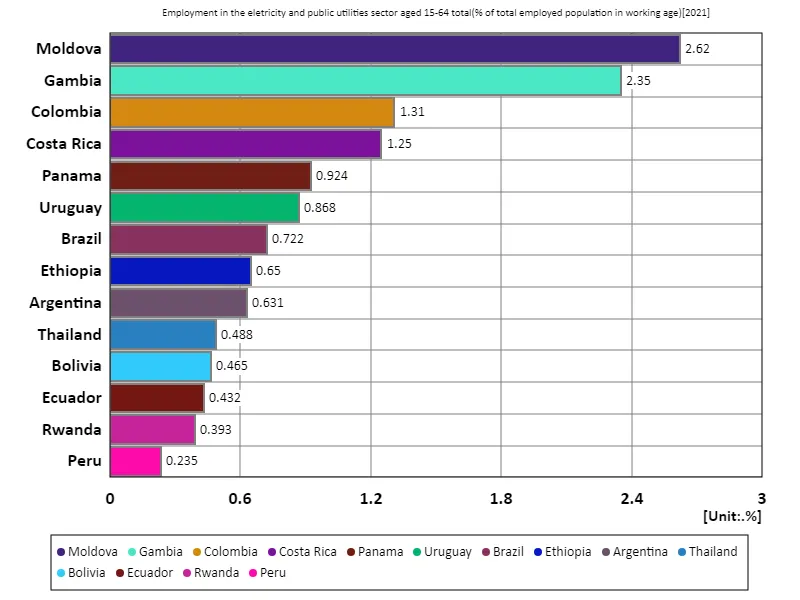- Abstract
- Employment rate for all 15-64 year olds, electric utility companies (percentage of working-age population)
- Employment rate for the electric utility industry (percentage of working-age population) for all 15-64 year-olds (worldwide)
- Employment rate for 15-64 year olds overall, electricity utilities (percentage of working age employed population) (Worldwide, latest year)
- Reference
Abstract
The employment rate in the electric utility industry relative to the overall 15-64 age group reflects differences in each country’s economic development and industrial structure. According to the latest 2021 data, Moldova has the highest share at 2.62%, indicating that the country’s electrical utilities sector is a relatively important source of employment. In countries with a high ratio, such as Moldova, the development of electricity and public infrastructure often accounts for an important part of the economy. In general, employment rates in electrical utilities are relatively low in developed countries and often represent a small proportion of the overall employment structure. This is due to developed countries shifting towards diversifying industries and becoming highly efficient in the power and public works sectors. On the other hand, in developing countries and countries with economies in transition, electric utilities can be an important source of employment. This is because infrastructure development is ongoing and workforce capacity in these areas is critical. As the example of Moldova shows, employment rates in the electrical utilities sector are a useful indicator of a country’s economic maturity and stage of industrial development.
Employment rate for all 15-64 year olds, electric utility companies (percentage of working-age population)
Looking at data from 1981 to 2021, employment rates in electric utilities have shown wide variation across countries. In particular, Kyrgyzstan recorded a high employment rate of 33.1% in 2017, but this has now fallen to 6.54%. These fluctuations reflect changes in the economic structure and improvements in the efficiency of public works. In the 1980s and 1990s, many countries achieved economic growth supported by electricity utilities. However, with the advancement of technological innovation and economic globalization, employment in public works gradually declined. In particular, as efficiency improvements and privatization in the power sector progress, traditional employment opportunities tend to be reduced, leading to a decline in employment rates. As the example of Kyrgyzstan shows, the high employment rate at its peak indicated the important role that the electric utility played in the country’s economy at the time, but economic changes and policy influences have altered the employment structure, resulting in the current low employment rate. Overall, it can be said that the employment rate in the electric utilities industry is an indicator that is strongly influenced by each country’s stage of economic development and its industrial policies.


The maximum is 33.1%[2017] of Kyrgyzstan, and the current value is about 6.54%
Employment rate for the electric utility industry (percentage of working-age population) for all 15-64 year-olds (worldwide)
Throughout the data from 1981 to 2021, employment rates in electric utilities have varied widely across countries. The case of Kyrgyzstan is particularly striking, having recorded a high employment rate of 33.1% in 2017, but which has now fallen to 6.54%. This change reflects the country’s economic growth and changing industrial structure. Over the past few decades, electric utilities have been a major source of employment in many countries, especially in developing countries. However, technological innovation and efficiency gains are enabling power and public infrastructure to be managed more efficiently, which is contributing to a decline in employment rates. In addition, direct employment is declining as many countries move to privatize or outsource electric utilities. In the case of Kyrgyzstan, high employment rates at peak times indicated the importance of utilities, but economic changes and policy reviews led to a decline in the relative importance of electricity utilities. Overall, the employment rate in the electric utility industry is an indicator that is strongly influenced by the stage of economic development and policies, and is characterized by dynamic changes due to technological advances and industrial changes.


The maximum is 33.1%[2017] of Kyrgyzstan, and the current value is about 6.54%
Employment rate for 15-64 year olds overall, electricity utilities (percentage of working age employed population) (Worldwide, latest year)
Data for 2021 shows that employment rates in electrical utilities are relatively low across the world, with Moldova recording the highest rate of 2.62%. The average employment rate is 0.952%, with the overall total employment rate being 13.3%. This trend indicates that although electric utility employment plays an important role globally, it represents a small proportion of the overall labour market. The trend over the past few decades has been a general decline in employment in electric utilities. This is due to technological advances, efficiency gains and, in many countries, privatisation. In many developed countries, the electric utility sector has become more efficiently run, reducing the need for employment. However, in developing and emerging economies, the public sector remains an important source of employment, which is reflected in high employment rates. In a country like Moldova, the electrical utility sector is a significant part of the economy and therefore has a relatively high employment rate, but overall the reality is that electrical utility jobs represent a small proportion of the total employment market. As technological innovation and economic globalization progress, this trend is expected to continue.


The maximum is 2.62% of Moldova, the average is 952m%, and the total is 13.3%



Comments